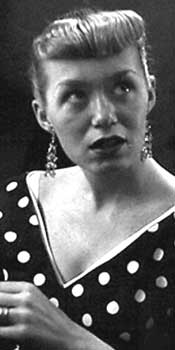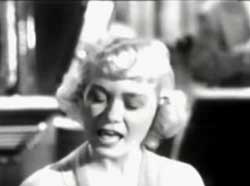 The Snader telescription Taking a Chance on Love (1950) opens on the Ernie Felice Quartet in front of a curtain. From left to right these guys are clarinetist Dick Anderson, accordionis Ernie Felice, guitarist Dick Fisher & Rolly Bundock on the slap base.
The Snader telescription Taking a Chance on Love (1950) opens on the Ernie Felice Quartet in front of a curtain. From left to right these guys are clarinetist Dick Anderson, accordionis Ernie Felice, guitarist Dick Fisher & Rolly Bundock on the slap base.
With a jump-cut we see there's additionally a pianist, Claude Williams, beside whom June Christy sings: "Here I go again/ I hear the trumpets blow again/ All aglow again/ Taking a chance on love..."
It's a pleasant standard; & June has a pleasant voice. However, it only adds up to a workmanlike effort, perfectly competent but nothing special. When we reach the instrumental break & get Ernie's accordion solo, it's just a reminder that it's awfully hard to make that instrument sound cool, Ernie having been good enough to have playedh is with Benny Goodman notwishtanding.
Clarinet & piano solos follow; they're okay, again not special. Then June's back for the vocal finish. She's pretty but a mite too Doris Day -- not coincidentally, the Ernie Felice Quartet had also provided back-up for Doris. It's like the church congregation's idea of a secular night out.
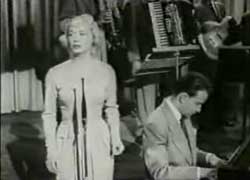 June Christy stars in the Snader telescription All God's Children Got Rhythm (1950), again backed by the Ernie Felice Quartet. Though it looks like they've got five guys rather than four, the pianist was not part of the quartet but was June's regular accompanyist.
June Christy stars in the Snader telescription All God's Children Got Rhythm (1950), again backed by the Ernie Felice Quartet. Though it looks like they've got five guys rather than four, the pianist was not part of the quartet but was June's regular accompanyist.
We see the same stage from Taking a Chance on Love but from an angle that reveals a ghastly big pot on a pedistal as one of the decorations. All June's telescriptions are on this stage set-up.
If you didn't know the song, you'd start slow-dancing cheek to cheek with your partner as June sings way-slowly: "Children listen here to me/ This is my philosophy/ To see me through the day/ To scare my cares away."
Just as you're getting comfy form-fitted to your date's curves, Claud's piano strikes an upbeat & June starts a snazzy jazzy rendition: "All god's children got rhythm/ All god's children got swing/ Maybe haven't got money/ Maybe haven't got shoes/ But all god's children got rhythm/ For to chase away the blues."
It's a great song but this rendition is merely good, not great. Fragments of the vocal about two-thirds through are actually praiseworthy. But in total, June's just not as good as she seems when backed Stan Kenton's orchestra. This is June being wholy qualified, yet bland.
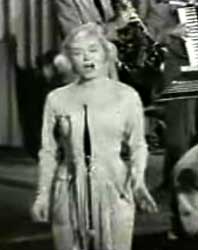 The opening card on this one identifies this as a "Studio Telescription" most of which were made in 1953 & 1954, but really S'pposin' (1950) is another Snader filmed in on the same set as all the June Christy Snaders. When Studio bought up the backlist from Snader, they put their own company info at the start of the any of the performances they continued to distribute as separate mini-films. The opening card on this one identifies this as a "Studio Telescription" most of which were made in 1953 & 1954, but really S'pposin' (1950) is another Snader filmed in on the same set as all the June Christy Snaders. When Studio bought up the backlist from Snader, they put their own company info at the start of the any of the performances they continued to distribute as separate mini-films.
Because these telescriptions were filmed all in one day, on one set, when run together have the effect of veritable concert. If you're a big fan of June's voice then it'll be a mellow evening. If you expect a bit of excitement out of a singer then it's a bland evening.
S'pposin' starts off with clarinet & accordion from the Ernie Felice Quartet. Then, cut to June singing: "S'pposin' I should fall in love with you/ Do you think that you could love me too/ S'pposin' I should hold you & caress you/ Would it impress you/ Or distress you..."
The lyric is kind of ordinary; the melody nice but unexceptional. Claude's piano solo is is the best thing here, but the clarinet & accordion solos drag.
There's a laziness about these performances, as though everyone involved, including June out front, were keeping it lowkey so as not to get worn out for three shows a night, a different town each night.
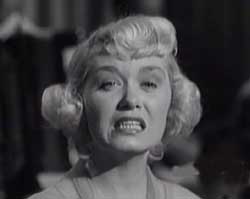 June Christy's telescription He's Funny That Way (1950) is a basic & for my ear generic rendition, at the high end of technical talent but with far too little personality to suit my tastes, & again rather too much like Doris Day.
June Christy's telescription He's Funny That Way (1950) is a basic & for my ear generic rendition, at the high end of technical talent but with far too little personality to suit my tastes, & again rather too much like Doris Day.
Others will disagree, but on the yellow-haired white-o-meter for swing jazz I would put Ina Ray Hutton, Dinah Shore & Peggy Lee at the pretty-darned-good end of the meter & Doris Day at the music-for-saps end. And on several recordings from June Christy's early solo career, she's far too Dorissy.
She sings He's Funny That Way at a very slow tempo, which is in fact one of her strengths, & the quintet plus piano perform faultlessly compared to some of the Christy accompaniments.
With lyrics a bit at variance with the original Richard A. Whiting & Neil Moret composition, Christy sings:
"I'm not much to look at; nothing to see/ I'm just glad I'm living & lucky to be/ But I got a man crazy for me/ He's funny that way/
"When I hurt his feelings once in a while/ His only answer is one little smile/ I've got a man crazy for me/ He's funny that way..."
If you've heard Billie Holiday's rendition, you may be inclined to agree with me that Christy falls a mite short, even if deserving someone to be her champion.
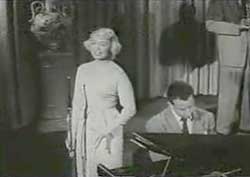 The year she made the Snaders was the first year she began building a solo career, but she'd continue for about another four years to also sing with the Stan Kenton Orchestra, then strike out on her own entirely, with a good deal of success.
The year she made the Snaders was the first year she began building a solo career, but she'd continue for about another four years to also sing with the Stan Kenton Orchestra, then strike out on her own entirely, with a good deal of success.
All June's telescriptions have the Ernie Felice Quartet in them, & nobody even changes positions on the stage from one mini-film to the next. I think the quartet holds June back somehow, & she'd come off better if Ernie & his guys would leave & June had only her pianist Claude Williams backing her.
My wish came true for Imagination (1950). The quartet is present but not playing. To Claude's excellent clean accompaniment June is singing huskily at the bottom of her register, sexier than any of the other Snaders.
She sings: "Imagination -- it's funny -- it makes the whole world seem solid -- makes a bee think of honey -- just as I think of you...."
It couldn't be stretched out any slower, & that is in fact one of her skills, to slow down a song & make it sound right. When a band rushes her vocals she completely loses it.
I'm still not completely won over to her style, but Imagination shows her at her best -- her best without the Kenton orchestra that is, she's resoundingly better with Stan.
However, in the early '60s she'd get back together with the Kenton Orchestra, & it was no longer a marriage made in heaven, as Stan's arrangements were swifter & no longer taylored to June's highest appeal with slow & sustained notes.
copyright © by Paghat the Ratgirl
|
